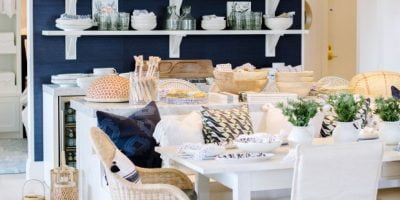
As a general rule, color palettes and fabric patterns should be consistent between indoor design and outdoor furniture.
For some folks, a few white plastic chairs around a fire ring are all it takes to spruce up the patio for maximum use and enjoyment. Others, including Anne LoCascio of Elgin, want the aesthetic they created indoors to carry through to the outdoors.
LoCascio owns a 1926 English Tudor cottage full of art deco antiques, and her design style doesn’t stop at her threshold. Outside, unifying elements include a classical fountain and garden vases, which “definitely are meant to be period-specific and to match the architecture and interior,” she says.
A seamless transition and sense of continuity make outdoor spaces more inviting, yet “far too often, the interior and exterior details clash,” says Bob Hursthouse, a landscape architect serving the Chicago suburbs.
Pay attention to these unifying design elements, and your deck or patio will feel like an extension of your indoor living space as opposed to an afterthought.
Color
Bright colors and tropical prints are popular choices for outdoor decor, but they can be a jarring mismatch for many interior design styles. You don’t want to create the sensation of walking out of Tara and into Margaritaville.
“Generally, fabric patterns and color palettes should harmonize with your indoor style to create a truly seamless flow,” says Joanne Jakab, an interior designer based in Burlington, Ontario.
You can, however, go with brighter hues and show a little less restraint for a more festive atmosphere. For example, a coastal palette of crisp white, washed-out pastels and sea glass colors can be punched up on the patio with beachy motifs — think starfish and seashells — that may be too literal or cheesy for inside the house.
On the other hand, if your interior tends toward Victorian excess, you may want to tone it down by using fewer colors and simpler patterns outdoors for a more relaxed, laid-back vibe.
“Choose neutral colors for big items like the hardscape and your larger furniture,” suggests Kate Wiseman, principal landscape designer at Sage Outdoor Designs in San Diego.
Rugs, throw pillows, planters and plantings can be added to echo or play off of an established color palette.

Form
Form is one of the most distinguishing features of architecture and interior design styles. Georgian, Colonial and Italianate architecture reveres symmetry, while Victorian, Queen Anne and contemporary houses are decidedly asymmetrical. Modern interior design verges on minimalism, while traditional design has more ornamentation.
Matters of form apply to every design decision, from your overall layout to decorative elements. Whereas loose, informal groupings complement a shabby chic aesthetic, a traditional design scheme begs for a “tight, tailored, orderly layout,” Hursthouse says.
Furniture pieces in a traditional design are typically placed in pairs and centered. Decorative pieces such as urns and plants are also displayed in pairs to achieve balance and symmetry.
Materials
The same piece of furniture can completely change the look of a space depending on the material choice. If you’re going for a modern look, consider using materials such as concrete, plastic, glass and shiny metals like stainless steel. Traditional materials include warm woods, wrought iron and wicker. A more rustic design style makes use of natural materials, such as stone, terra cotta and reclaimed lumber, as well as rough or nubby textures and distressed finishes. Coastal design calls for weathered wood, natural fibers, wicker, rattan and rope.
Materials selection doesn’t depend solely on indoor-outdoor continuity. Climate and durability are critical considerations because “no matter how much an outdoor living space looks and feels like the inside of your house, it’s not climate-controlled so fixed materials must be able to withstand moisture and temperature variations,” says Jerry Ponzo, owner of the landscape design-build firm Back Yard Dream, based in Rancho Cordova, California.

Furniture
“Today, outdoor furniture comes in as many styles as indoor furniture over a wide variety of price points,” Jakab says. “Rolled arms with higher backs mimic Victorian or Traditional while lower, squared arms and backs mimic more modern design styles.”
Although patio furniture is often upholstered to resemble indoor furniture, there’s a place for vintage metal (thigh-searing) lawn chairs, DIY pieces, flea market finds and traditional outdoor furniture such as patio bistro sets and garden benches.
“You can buy super-elegant wrought-iron benches with an unbelievable finish that shines like a Bentley,” Hursthouse says. Or, on the opposite end of the spectrum, you can make seating out of salvaged wooden pallets if your interior tends more toward shabby chic.
Details and accessories
Sometimes, all it takes are the smallest details to make an outdoor space cohesive. In fact, “These days, a lot of people are embracing a more transitional design style, so the outdoors may differ from the indoors except for some echoes here and there,” says Wiseman, adding that the departure is “deliberate and desirable.”
One reason is that people generally want a more laid-back atmosphere outside. A Chippendale sofa may grace the living room, while a few feet away on the outdoor patio, “the silhouette of the furniture may be streamlined, but there’s some fine detailing such as fancy scrollwork on the leg as a unifying element,” Wiseman says.
Details like lighting fixtures and statuary can be used to declare or merely suggest which design style is used inside the house.
Plantings
“Generally, a home’s landscaping should match its architecture and interior design,” Hursthouse says. “A soft, low-key, informal landscape with big, blowsy masses of hydrangea won’t work with an uber formal house.”
In fact, some design styles have “very established gardening styles associated with them,” Wiseman says.
In keeping with traditional English gardening, LoCascio has filled her flowerbeds with phlox, purple coneflowers, sunflowers, irises, salvia, roses and other bursts of color. More specifically, “I usually let the perennials reseed themselves for a classic ‘cottage garden’ look of undisciplined chaos,” she says.
Match container gardens to your overall aesthetic by choosing an appropriate vessel (whiskey barrel, clay pot, urn) and flora (tidy topiary, unruly fern, tropical hibiscus).


